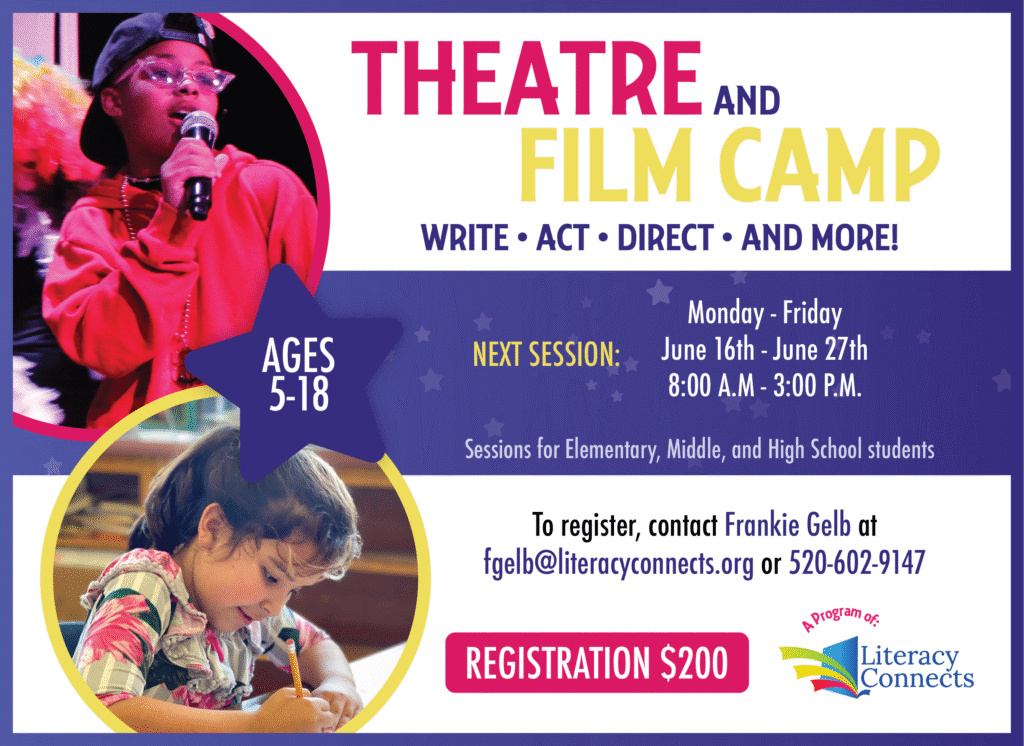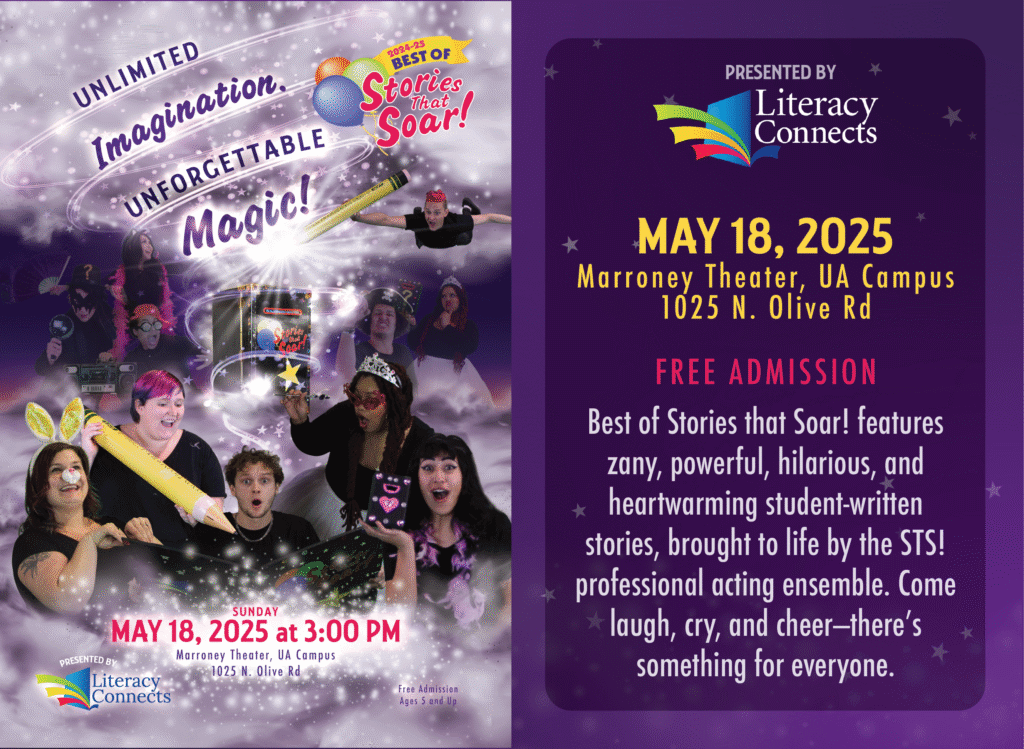
Thanks Adam Curtis at Willcox Range News for this wonderful article about Reach Out and Read Southern Arizona – A program of Literacy Connects.
Children who get checkups at the Chiricahua Community Health Centers do not ask for lollipops anymore—they ask for books.
Every now and then, Dr. Jonathan Lee-Melk, the medical director of community pediatrics, will forget to offer a book during one of his young patient’s routine wellness visits. When that happens, the family typically returns to the office, and the child reminds Lee-Melk about the book.
The books are given out as part of a nationwide program called Reach Out and Read, which the clinic joined because the program’s benefits extend far beyond encouraging literacy, according to Lee-Melk. Research shows that reading to a child is one of the best ways to help develop speech and language skills.
It is an interactive activity that allows the child to ask a parent questions, and activates parts of the brain that will benefit the child when starting school, Lee-Melk said.
“It’s not (just) our opinion; it’s well documented.”
On the other hand, there is no research that shows television has any benefit for children under the age of 3. In fact, TV has been shown to be detrimental, Lee-Melk said. After age 3, shows such as Sesame Street, which makes efforts to engage children with eye contact and participation, can have some benefit. But it’s not as helpful as the interactive experience that reading to a child offers.
From the time a child is 6 months old until about age 6, the brain goes through an extraordinary period of development that sets the foundation for the rest of the child’s life, Lee-Melk said. The neurons that are not used during this period are pruned back, because the brain assumes they are not needed.
Last year, the clinic gave out about 2,000 books to 1,000 different children, and Lee-Melk said he has been able to watch many of these children develop their speech in recent years. “It’s one of the greatest pleasures of being a pediatrician, frankly.”
Some of the families who come to the health centers can’t afford to buy children’s books of their own. But thanks to Reach Out and Read, one father had to build a bookshelf to hold all the books his children accumulated, Lee-Melk said.
That means the world to Lee-Melk, who firmly believes that reading to a child will give the child the opportunity to do well in school and succeed in life.
“It’s one of the reasons why we become pediatricians to begin with,” he said. “It’s a real privilege to be able to have this kind of impact in the lives of children and their families.”
BOOKS OVER BARNEY
Veronica Quintano has a busy schedule, but looks forward to the moments she can spend reading to her two daughters and son.
That’s how Quintano and her husband end most days, she said. Both her daughters enjoy reading, and her 3-year-old daughter, Kaitlyn Villa, has even started to correct her mother on certain words.
Kaitlyn has been going to the Chiricahua Health Centers since she was an infant, but started seeing community pediatrician Dr. Darlene Ray at the mobile clinic in Sierra Vista about a year ago, Ray said.
Kaitlyn has been diagnosed with cerebral palsy, and when Kaitlyn first came to the mobile clinic, she was essentially nonverbal.
But she has come a long way in the past year, Ray said. And reading to Kaitlyn at an early age will help her develop to her full potential and give her a chance to have the best possible outcome in life, Ray said.
Quintano’s 5-year-old daughter can already pronounce some words better than her mother can, although Quintano says it sometimes is difficult to get her 7-year-old son away from the TV and video games.
Quintano wishes her own parents had read to her as child and appreciates the encouragement she has received from the pediatricians at Chiricahua Community Health Centers.
Maria Morales has been bringing her year-old son, Cesar, to the mobile clinic since his first wellness exam at the age of 6 months, which was when he got his first book. Morales said Cesar has already begun to point to the pictures when she says certain words.
Morales also read to her 8-year-old son as he was growing up, and he can now read in two languages, she said. He is also a good student.
Ray spends about 30 minutes with the family during each wellness visit, which is actually a long time compared to most pediatrician appointments, she said. She is currently developing a curriculum centered on how to maximize the impact of the visits.
Early childhood development is Ray’s passion, and she has learned that cases of slow development often boil down to a lack of stimulation, and a lack of interaction with families.
She emphasizes to parents that television is not a substitute for real-life experience, although some parents are actually proud that their young children can sit through a whole episode of Barney, she said. The American Academy of Pediatrics recommends that babies not watch TV at all before age 2.
“It’s been correlated to developmental delays, so I really try to emphasize that to parents,” Ray said.
WHAT BABIES ARE HUNGRY FOR
Reach Out and Read is not just about teaching children to read, said Will Creamer, executive director of Reach Out and Read Southern Arizona. It’s also about encouraging interaction between children and their parents to help foster highly developed brains.
“Any time we share language with children … songs, reading books, having that personal face-to-face interaction, that’s what babies are hungry for,” Creamer said. “TV is just a glowing light bulb; it’s just meaningless.”
Although Reach Out and Read is a nationwide program, Creamer’s nonprofit independently raises money in Southern Arizona and distributes books and training materials to pediatricians in the area, he said. Many of the pediatricians also help purchase books.
Creamer’s 10-year-old organization distributes about $225,000 worth of books each year throughout Santa Cruz, Pima and Cochise counties. Reach Out and Read Southern Arizona supports more than 50 clinics, serves more than 34,000 children and distributes more than 60,000 books each year. “Once doctors do it, they love it,” Creamer said.
The Reach Out and Read Arizona Coalition reports that statewide, the programs reached 119,929 children at 180 sites and distributed 239,858 books in 2010.
Sonora Family Care and Pediatrics, Adolescents and Family Care are two other clinics in Sierra Vista that use the Reach Out and Read program.





